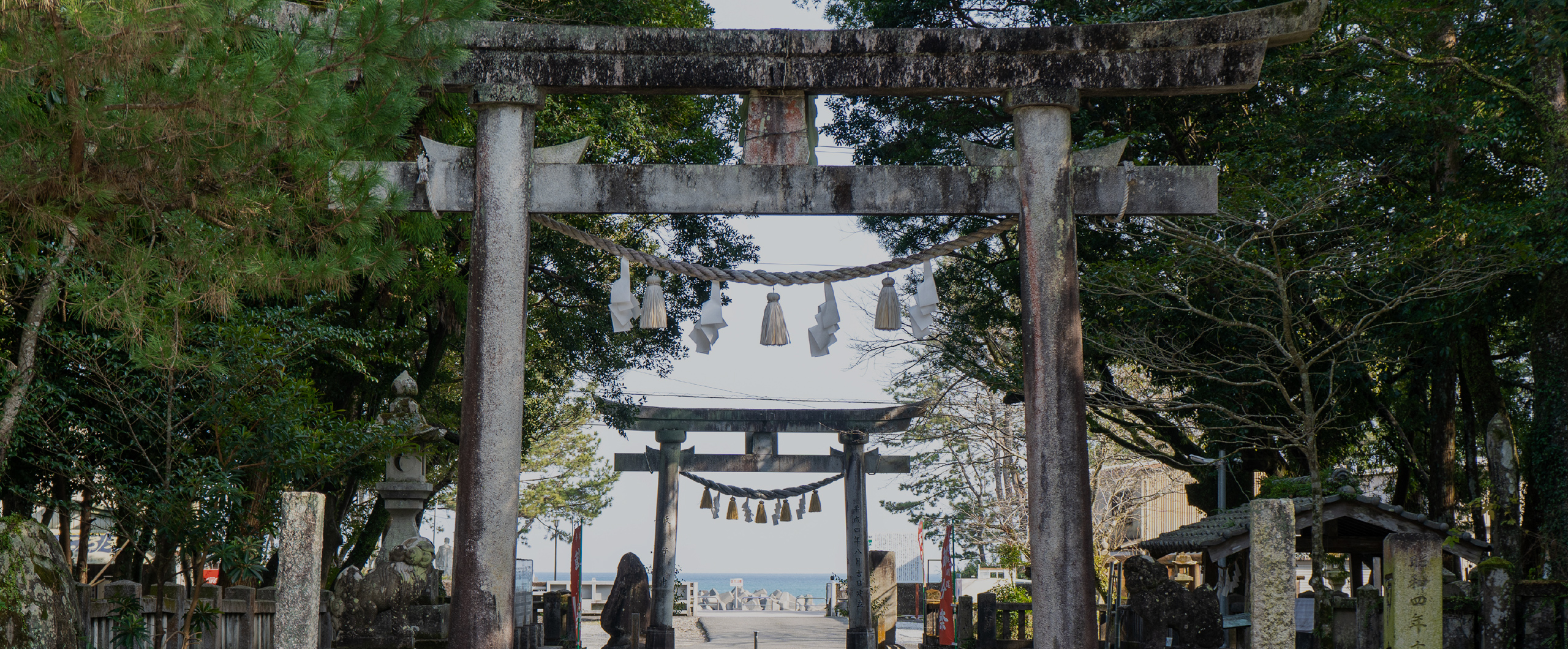This Shrine started in the middle ages as guardian for the feudal lord’s victory in the battle. Also, it has been the home of worship by the fisherman for the safe voyage on the high seas of the ocean. The shrine is facing the Pacific Ocean.
On the sacred treasure inherited in the shrine, the year 1392 is mentioned. Hence, the Shrine is assumed to be established before this year. The current structure was reconstructed in 1825. The shrine gets smaller as you go further into it, from above, it looks like a dragon fly. The dragon fly is a symbol of advancing forward and not retreating, the god of the battlefield.
Towards the left of the shrine is the Good Luck Stone. It has been said from ancient times that if you go through the hole of this huge stone starting from your head, and then make your prayers to the sacred tree of Kusunoki, you will get purified and receive blessings. Also, the passing through this hole = means “passing” your entrance exams and interviews with good fortune. The hole has been made from natural running water for thousands of years.
The annual festival “Kure Hachimangu Shrine Autumnal Festival” is among Kochi’s 3 Major Festivals which starts from the lunar calendar of August 1st and continues for 2 weeks. Its tradition starts from the Sengoku Era (civil war period 1450-1600) over 600 years ago. In order to receive the blessings from the moon, the festival starts on the evening of the new moon and ends at the full moon. The highlight of the festival comes at the climax days of August 14th and 15th when the events of “Omikokusan”, “Onabare”, and the “Kenka Taiko” which drums are beaten by each other for competition. “Omikokusan” is an offering of the year’s harvest
to the gods, and newly harvested rice, sake and rice cakes are presented before the altar. It is to thank god for the rich autumn harvest and pray for peace, prosperity of the region. In order to expel evil spirits and welcome the gods, 40 men will carry a large torch (6 meters long weighing 1 ton) and march around the town from the middle of night to dusk.The “Onabare” is a sacred ceremony in which the gods will leave the shrine once a year to check out the town, the sacred arc is paraded around the township. There is also the lion dance by “Shishimai” and “Tengu” which expels evil spirits and achieve happiness. It is said from ancient times that if your head gets bitten be the Shishi (lion) the evil spirits will go away.
The Way to Make Prayers & Worship
-
-
- 01
- Make one bow in front of the Torii gate.
Walk on the sides of the entrance path since the gods walk in the center.
-
-
- 02
- Wash your hands at the water bath.
-
- a
- Scoop the water with the dipper on your right hand and purify your left hand.
- b
- Hold the dipper on your left hand and purify your right hand.
-
- c
- Next hold the dipper again on your right hand, drain your left hand and then rinse your mouth.
- d
- Purify your left hand again.
-
- e
- Then place the dipper perpendicularly, wash your hand with the remaining water and place the dipper back.
-
-
-
- 03
- Move forward to
the front of the altar. - 04
- Throw your coin
into the offering box. *Tip - 05
- To call the gods,
shake the rope
in front and ring the bells.
-
Tip
In the old days, rice would be presented in fron of the altar as a ritual of offerrin the gods one’s earnings and comminitment to his efforts and work.
Also, horses were the most important symbol of farming and admired. Today the “Ema”, or picture of the horse on wooden frames are dedicated to the Shrine.
-
-
-
- 06
- Bow.
-
- a
- Deeply bow continuously 2 times.
-
- b
- Clap twice.
- c
- Place your palms together
and make your prayers.
-
- d
- Drop your hands and make a deep bow.
-
-
-
- 07
- Return to Torii gate,
face back to the shrine and
make a final bow.
-



